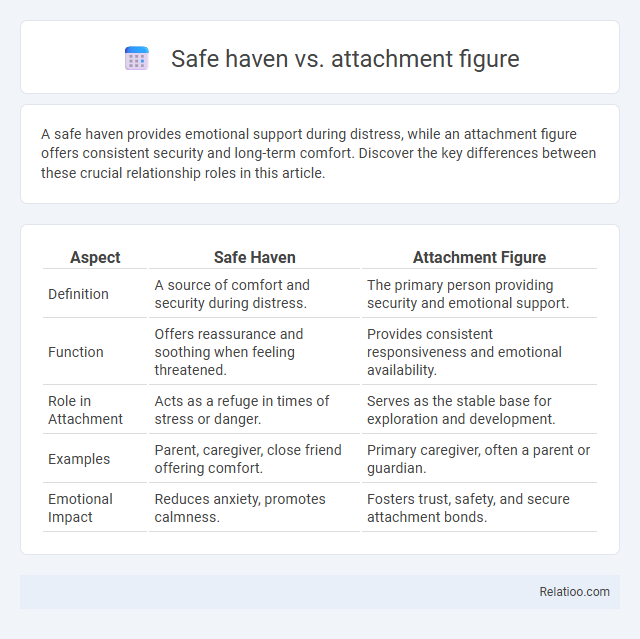A safe haven provides emotional support during distress, while an attachment figure offers consistent security and long-term comfort. Discover the key differences between these crucial relationship roles in this article.
Table of Comparison
| Aspect | Safe Haven | Attachment Figure |
|---|---|---|
| Definition | A source of comfort and security during distress. | The primary person providing security and emotional support. |
| Function | Offers reassurance and soothing when feeling threatened. | Provides consistent responsiveness and emotional availability. |
| Role in Attachment | Acts as a refuge in times of stress or danger. | Serves as the stable base for exploration and development. |
| Examples | Parent, caregiver, close friend offering comfort. | Primary caregiver, often a parent or guardian. |
| Emotional Impact | Reduces anxiety, promotes calmness. | Fosters trust, safety, and secure attachment bonds. |
Understanding Safe Haven and Attachment Figure
A safe haven provides emotional comfort and protection during times of distress, serving as a secure place an individual can retreat to for reassurance. An attachment figure, typically a caregiver or close person, plays a crucial role in offering both a safe haven and a secure base for exploration, fostering emotional security and healthy development. Understanding safe haven involves recognizing its function as a source of immediate support, while the attachment figure represents the stable presence that consistently meets emotional needs.
Key Differences Between Safe Haven and Attachment Figure
A safe haven provides comfort and reassurance during times of distress, acting as a source of immediate emotional support. An attachment figure, however, represents a long-term relational bond that offers security, shaping your overall emotional development and sense of stability. Unlike a safe haven, an attachment figure serves as a consistent presence in your life beyond just moments of crisis.
The Role of Safe Haven in Emotional Development
The role of a safe haven in emotional development is to provide a secure and comforting presence that allows Your child to explore the world while knowing they have a reliable source of protection during times of distress. Unlike an attachment figure who forms the basis of a deep emotional bond, the safe haven specifically functions as a refuge for emotional regulation and stress relief. This consistent support fosters resilience and helps develop healthy coping mechanisms essential for long-term emotional well-being.
Attachment Figure: Who They Are and Why They Matter
An attachment figure is a trusted person, often a caregiver or close loved one, who provides emotional security and comfort, especially in times of stress or uncertainty. They serve as a safe haven, offering protection and reassurance that helps regulate your emotions and foster resilience. Understanding the role of your attachment figure is crucial for building healthy relationships and promoting psychological well-being.
Psychological Theories Behind Safe Haven and Attachment
Psychological theories emphasize the role of a safe haven as a secure base where Your emotional distress is soothed, distinct from an attachment figure who provides ongoing security and support. Attachment theory, pioneered by John Bowlby, highlights how a safe haven serves as a critical mechanism for emotional regulation, especially during times of threat or anxiety. Understanding the nuanced distinctions between safe haven and attachment figure deepens insights into human bonding and psychological resilience.
Impact on Child Development: Safe Haven vs Attachment Figure
Safe haven provides immediate comfort and protection during distress, fostering a child's sense of security and emotional regulation. An attachment figure serves as a consistent source of support and nurturance, shaping long-term social and emotional development by promoting trust and resilience. The impact on child development differs as safe haven responses primarily address acute stress, while attachment figures influence stable emotional bonding and healthy relational patterns over time.
Signs of a Secure Attachment Relationship
Signs of a secure attachment relationship include seeking comfort from an attachment figure during distress, using them as a safe haven for emotional support, and confidently exploring the environment knowing safety is guaranteed. Your ability to rely on this figure for reassurance without fear demonstrates trust and emotional security. Consistent responsiveness and sensitivity from the attachment figure reinforce these secure patterns, promoting healthy emotional development.
How Parents Can Be Both Safe Haven and Attachment Figure
Parents serve as both a safe haven and attachment figure by providing consistent emotional support and security, which helps children regulate stress and feel protected. Your role as a caregiver establishes a secure base, encouraging exploration and independence while ensuring your child returns to you for comfort and reassurance. This dual function strengthens your child's emotional resilience and fosters long-term healthy relationships.
Long-Term Effects on Adult Relationships
A safe haven provides emotional comfort during times of distress, fostering secure attachment styles that promote trust and intimacy in adult relationships. An attachment figure's consistent responsiveness during childhood shapes your ability to regulate emotions and maintain healthy, supportive bonds throughout life. Long-term effects include enhanced emotional resilience and reduced anxiety, contributing to stronger, more stable romantic and social connections.
Practical Tips for Fostering Secure Attachments
To foster secure attachments, caregivers should consistently respond to a child's distress with sensitivity and calm, providing a reliable safe haven that promotes emotional regulation and trust. Encouraging exploratory behavior while remaining physically and emotionally available establishes an attachment figure who supports both comfort and autonomy. Practical practices include maintaining predictable routines, offering reassurance during stress, and validating feelings to strengthen the child's internal sense of security.

Infographic: Safe haven vs Attachment figure
 relatioo.com
relatioo.com